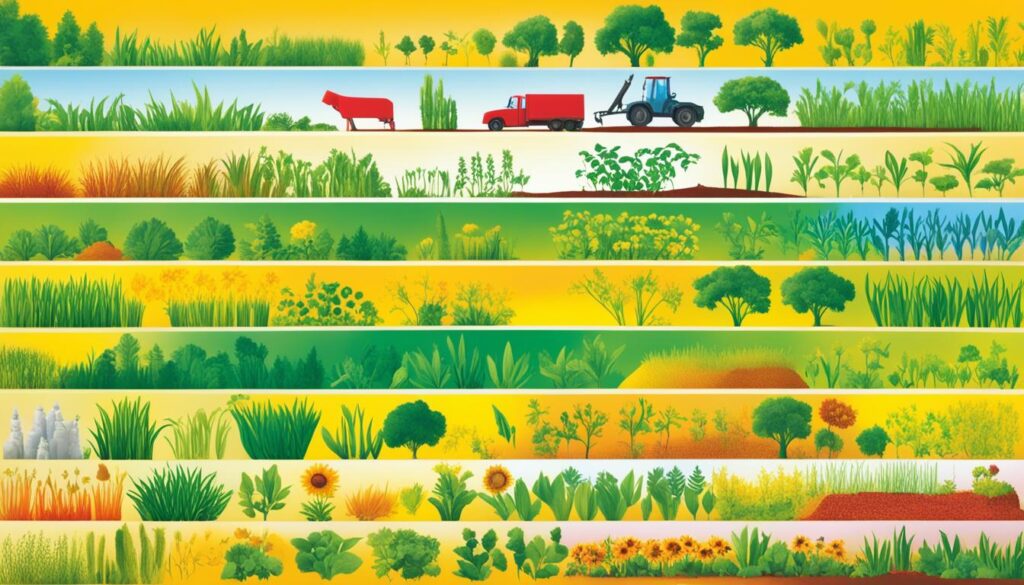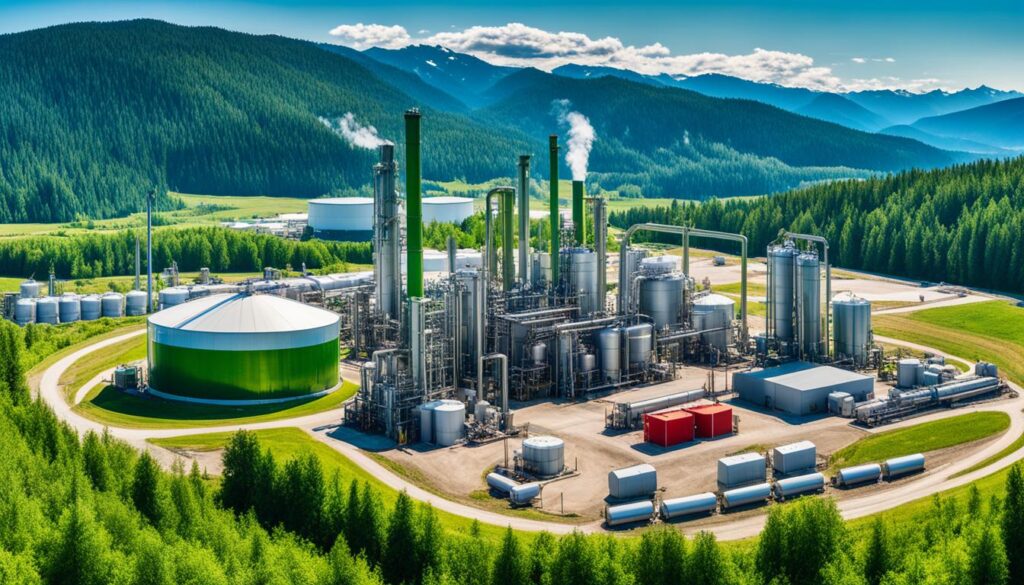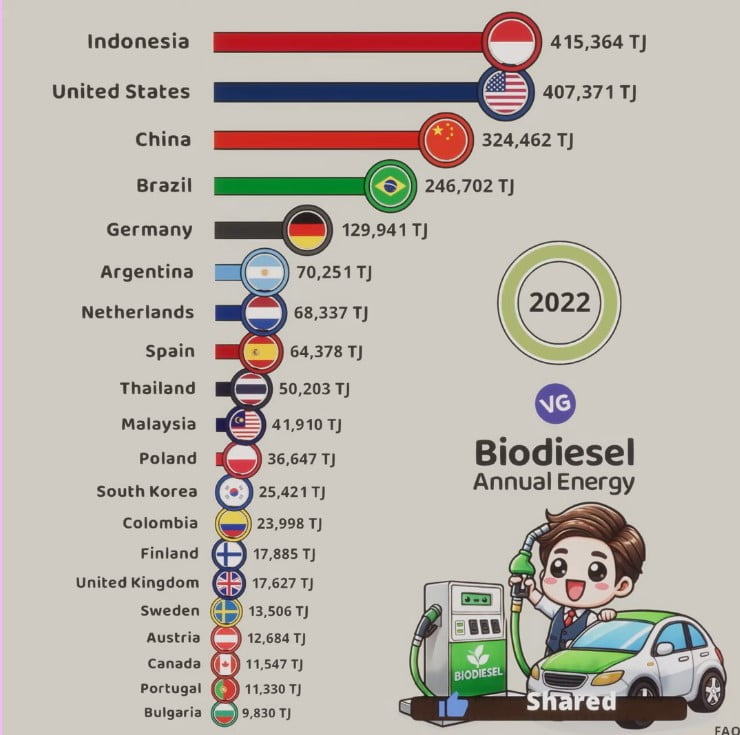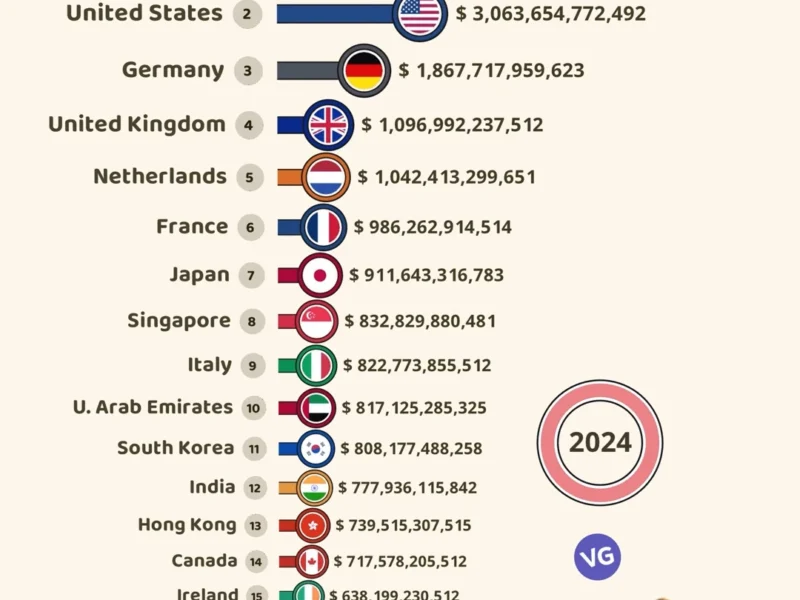The global biodiesel market has seen huge growth, hitting $36.48 billion in 2022. It’s expected to jump to $79.12 billion by 2032, showing a 8.1% rate of growth each year1. This big increase shows the world wants more renewable energy to fight climate change. Nearly all of the industry’s materials, about 96.4%, come from vegetable oils1. With countries around the world pushing to lower their greenhouse gas outputs, biodiesel is becoming very important. Leading biodiesel makers globally are changing how we get energy.
World Biodiesel Production 2022
| Country | Biodiesel Annual Energy (TJ) | Flag |
|---|---|---|
| Indonesia | 415,364 | 🇮🇩 |
| United States | 407,371 | 🇺🇸 |
| China | 324,462 | 🇨🇳 |
| Brazil | 246,702 | 🇧🇷 |
| Germany | 129,941 | 🇩🇪 |
| Argentina | 70,251 | 🇦🇷 |
| Netherlands | 68,337 | 🇳🇱 |
| Spain | 64,378 | 🇪🇸 |
| Thailand | 50,203 | 🇹🇭 |
| Malaysia | 41,910 | 🇲🇾 |
| Poland | 36,647 | 🇵🇱 |
| South Korea | 25,421 | 🇰🇷 |
| Colombia | 23,998 | 🇨🇴 |
| Finland | 17,885 | 🇫🇮 |
| United Kingdom | 17,627 | 🇬🇧 |
| Sweden | 13,506 | 🇸🇪 |
| Austria | 12,684 | 🇦🇹 |
| Canada | 11,547 | 🇨🇦 |
| Portugal | 11,330 | 🇵🇹 |
| Bulgaria | 9,830 | 🇧🇬 |
Key Takeaways
- The global biodiesel market has experienced remarkable growth, reaching $36.48 billion in 2022 and projected to surge to $79.12 billion by 2032.
- Vegetable oils make up 96.4% of the industry’s feedstock, highlighting the sector’s commitment to sustainable practices.
- Leading biodiesel producers worldwide are driving the energy transition, with a focus on reducing greenhouse gas emissions.
- Government incentives and subsidies have played a crucial role in the industry’s expansion, helping to bridge the price gap with fossil fuels.
- The United States, Brazil, and Indonesia are among the top biofuel-producing countries, accounting for a significant portion of global production.
Introduction to the Biodiesel Industry
Biodiesel Annual Energy Production (2022)
Source: Image provided (2022)
Biodiesel is a renewable liquid fuel that’s a clean alternative to diesel made from petroleum. It’s made by mixing alcohol with vegetable oil, animal fat, or used cooking grease. This method makes it biodegradable and nontoxic2.
Switching to biodiesel helps the environment. Traditional diesel releases harmful toxins. Biodiesel offers a cleaner, friendlier option3.
Growth and Demand Drivers
The biodiesel industry is growing fast. By 2032, it’s expected to be worth $79.12 billion. The main materials used are vegetable oils, making up almost all sources2. Fuel alone brings in 79% of the biodiesel industry’s income2.
Challenges and Opportunities
The cost of making biodiesel can be high, mainly due to the price of raw materials. These prices can change a lot. But the industry has a big chance to grow. There’s really no other alternative to fossil fuels right now. Plus, its positive environmental impact and its fit with modern engines are great signs for future success2.
“Biodiesel can lead to reductions in life cycle emissions of total particulate matter, carbon monoxide, and sulfur oxides by 32%, 35%, and 8%, respectively, compared to petroleum diesel.”3
Biodiesel comes from many sources like soybean and palm oil. There are various mixtures available, from 1% biodiesel to pure biodiesel. These mixes are called biodiesel blends3.
The biodiesel industry is facing challenges but also has big chances to grow. The need for clean, renewable energy is increasing. With growing technology and new sources, the future looks bright234.
Current Biodiesel Production Statistics
The biodiesel and biofuel industry has grown a lot in recent years. This growth comes from higher demand for green energy. In 2022, the need for biofuels is predicted to rise by 6%. That’s 9,100 million liters more than in 2021. This jump is thanks to good policies in several key places, including the United States and Europe5.
In 2022, Indonesia leads as the top biodiesel producer. It made 7.75 billion liters. Brazil and the United States follow closely, making 5.4 billion liters and 5.12 billion liters respectively2.
The United States, Canada, Brazil, Indonesia, and India are key in biofuel’s global growth. They drive 80% of this growth. Also, over the next five years, richer countries will need 20% more biofuels5.
Almost 70% of renewable diesel and biojet fuel in 2021 came from waste. This shows how important using leftover materials is for the industry5.
The push for green energy means more biofuels in the future. By 2027, biofuels will make up 5.4% of what we use in vehicles. We’ll see the need for biojet fuel grow. By 2027, it will make up nearly 1% of all jet fuel used5.
The United States, China, Europe, and India play a big part in this shift. They aim to use 240,000 million liters of biofuel by 20275.
This info shows how the world is moving towards biodiesel and biofuels. It’s because of policies, new ideas, and a focus on the environment. Keeping an eye on this sector is important. We need to watch out for new trends and changes in biodiesel and biofuel production around the world562.
The Largest Biodiesel Producers in the World
Indonesia is the top biodiesel producer globally. In 2022, it made around 7.75 billion liters. This shows how strong its palm oil industry is6. With this, Indonesia leads the way in the biofuel production scene1.
On the other side, the United States is third in line, making 5.12 billion liters in 20221. Renewable Energy Group (REG) is the top producer here, making more than 600 million gallons yearly6. Companies like Archer-Daniels-Midland Co (NYSE:ADM) play a big role too. In 2022, they had a $101.8 billion income and are well-known in the biodiesel market2.
| Country | Biodiesel Production (Million Gallons) |
|---|---|
| Indonesia | 2,048 |
| United States | 1,352 |
| Brazil | 1,460 |
| Argentina | 554 |
| France | 544 |
| Spain | 356 |
| Thailand | 351 |
| Colombia | 184 |
| India | 48 |
The global biodiesel market is set to expand greatly. By 2032, it might hit $79.12 billion. This could happen with a yearly growth of 8.1%2. Such growth is a sign of the increasing need for eco-friendly fuel options. It makes the biodiesel industry even more important in our move towards green energy2.
“Indonesia’s abundant palm oil resources have fueled the remarkable growth of its biodiesel sector, making it a dominant force in the global biofuel production landscape.”
European Powerhouses: EU’s Biodiesel Landscape
The EU is second in the world for producing biodiesel7. France and Spain are key in making this happen. They are leading the way in the EU.
France and Spain: Key Contributors
France leads the EU in biodiesel production, making 544 million gallons in 20227. Spain follows with 356 million gallons, ranking eighth globally7. These countries are important in the world’s biodiesel business because of their large production numbers7.
Biodiesel is in high demand across Europe. France and Spain are important suppliers, showing their big share of the market7. This shows just how much they contribute to the world’s renewable energy needs7. With the EU pushing for more renewable energy, the roles of France and Spain are key8.
“The European Commission’s renewable energy directive aims to more than double the EU’s use of crop-based biofuels by 2020 despite warnings that they may not effectively reduce emissions.”9
Yet, there are issues in the EU’s biodiesel sector. Using crops for biofuels is controversial due to their effects on the environment9. They can lead to more greenhouse gas emissions and even deforestation9. The EU must tackle these tough problems for a cleaner, greener biodiesel field897.
Emerging Markets: Asia-Pacific and South America
The world’s biodiesel production is going up, with growth seen in the Asia-Pacific region and South America. Brazil and Argentina have become important in making biodiesel. They use a lot of soybean oil to power their biodiesel production10.
Brazil and Argentina: Soybean Oil Biodiesel
Brazil is the world’s second-largest biodiesel maker, producing about 5.4 billion liters in 202210. It heavily relies on soybean oil for this. Even so, they still blend 10% biodiesel in their diesel as of 202210. Argentina stands as a big player too. They’re the planet’s sixth-largest biodiesel producer, using soybean oil mainly. In 2022, they made around 554 million gallons10.
In the Asia-Pacific region, biofuels like biodiesel and bioethanol are set to grow a lot. By 2031, this market could be worth USD 61.28 Billion. That’s an 8.33% growth rate, thanks to a rising population and incomes. China and India are big reasons for this growth11.
The U.S. and Europe are big in the biodiesel world, but the Asia-Pacific area and South America are catching up. As the world looks for more renewable energy, these regions are ready to meet the demand. This shows the potential for biodiesel in these markets101211.
Biodiesel Production Processes and Feedstocks
In making biodiesel, vegetable oils and animal fats are key. Around the world, 96.4% of biodiesel comes from vegetable oils13. The top choices are soybean, palm, and rapeseed oil. In the United States, soybean oil is especially important14.
Animal fats from meat plants and used cooking oil also make a big impact14. Together, these sources help create renewable, clean fuel.
Emerging Biofuel Technologies
New biofuel tech is always popping up to meet our green energy needs. Algae, for example, could be a big deal thanks to its high fat levels14. These fats can turn into biofuels.
Renewable diesel is another star on the rise. It’s like regular diesel but cleaner, and you can use it on its own14.
There’s also hope for greener jet fuel. Known as Sustainable Aviation Fuel (SAF), it allows for a mix of 50% bio-based parts and 50% usual jet fuel. This blend cuts down on aviation’s carbon footprint14.
The biofuels market is expanding beyond biodiesel and renewable diesel. Now, there’s a push for greener versions of naphtha, gasoline, propane, and jet fuels made from alcohol or ethanol, like ATJ or ETJ fuels14.
| Feedstock | Global Usage in Biodiesel Production |
|---|---|
| Vegetable Oils | 96.4%13 |
| Animal Fats and Used Cooking Oil | Significant contributors14 |

“Demand for vegetable oil, waste, and residue oils and fats is expected to increase by 56% to 79 million tonnes from 2022 to 2027.”15
The biodiesel sector is an important player in our changing energy world. It continually brings in new ideas to keep up with the need for clean, sustainable fuels131415.
Environmental and Economic Impact
The way we produce world biodiesel and biofuel has a big effect on our planet and pocketbooks. Biodiesel, a clean fuel, is better than regular diesel because it’s eco-friendly and safer. It can cut down harmful emissions a lot, up to 70% less than the old kind16. Recent studies show that on average, biofuels emit 46% fewer greenhouse gases than gas16. These findings show how important biodiesel is for a greener and more renewable future.
Greenhouse Gas Emissions Reduction
There’s a rising demand for cleaner fuel in the world energy renewable diesel sector. Biofuels are leading us to a future with almost no extra emissions, which helps everyone and everything16. Choose biodiesel, and you could help make the air cleaner. It might cut down asthma cases and sick days, saving money and boosting the economy big time17. Using it in cars and to heat homes might even save billions in health costs17.
Government Incentives and Subsidies
In many countries, governments have helped a lot to grow the global biofuel and biodiesel markets16. Because making biodiesel is more expensive than the old ways, these aids are really important. In the U.S., most gas already has some biofuel mixed in. They’re working to make that mix even larger16. In Brazil, cars can run completely on biofuel, thanks to their government’s rules16.
The world biodiesel production is making a big difference in how we see our environment and economy16. With the push to cut down on emissions and the support from governments, biodiesel keeps getting better. This story is far from over. The biodiesel industry is set to become a key player in our move to cleaner, renewable energy16.
| Environmental Impact Indicator | Value for Cottonseed Biodiesel Production |
|---|---|
| Destruction of living resources | 5.00 × 10−3 kg Sb-eq |
| Acidification potential | 17.5 kg SO2-eq |
| Global warming potential | 1475 kgCO2-eq |
| Eutrophication potential | 10 kg PO4-3 |
As the use of world energy renewable diesel grows, it’s vital to look at how it affects our planet18. For example, making diesel from cottonseeds causes certain environmental issues. But ongoing work is aiming to make biofuel production much kinder to our world18.
“Biofuels drive down carbon emissions 46% better than gasoline, with the industry heading towards even greater reductions.” – POET
Both global biofuel and biodiesel production worldwide are really good for our environment and economy16. Thanks to government help and ongoing studies, the future of biodiesel looks bright. It’s set to be a major contributor to cleaner air and more financial growth161718.
Future Outlook and Trends
The world of biodiesel production is on track for more growth. In 2021, it was a USD 32.09 billion market. Expected to rise, with a 10.0% yearly jump, until 203019. This drive comes from our need for green, clean energy and the dwindling fossil fuels19. Plus, new methods and materials are making biodiesel production cheaper, helping the field grow even more19.
By 2021, vegetable oils made up over 97.00% of biodiesel’s earnings19. Europe had a big 46.7% piece of the market last year. It’s set to keep growing until 203019. Biodiesel was mainly used in vehicles, making up 77.7% of all sales in 202119.
Thinking globally, the biofuel production field is about to take off. In Central & South America, the 2021 output hit 10,960.1 million liters19. By 2030, we predict the biodiesel market will reach USD 73.05 billion. It’s looking at a 10.0% annual growth between 2022 and 203019.
Several countries are pushing biodiesel production forward. The U.S., U.K., Germany, and many others are leaders. They’re at the front not just on a national level but worldwide. Their focus on renewable energy is key20.

The future of biodiesel is bright. With growth and new ideas, the world biodiesel production will soar1921.
“The biodiesel industry is poised for a bright future, as the global demand for renewable energy sources continues to rise and technological advancements make production more cost-effective.”
Conclusion
The biodiesel industry has grown a lot lately, thanks to countries like Indonesia, Brazil, and the United States22. In the U.S., there’s a big production capacity of 2.3 billion gallons each year. Places like Iowa and Texas lead in making biodiesel22. This growth is powered by the search for new fuel options. It’s likely to keep growing until it hits $79.12 billion by 203223.
The field faces some hurdles due to high costs. Yet, its eco-friendly benefits and the need to move from fossil fuels open big doors24. For example, biodiesel from soybeans needs little fossil fuel energy. Plus, it cuts emissions more than petrodiesel24. In the push for greener energy choices, biodiesel and other biofuels are vital. They’re expected to shape the renewable energy market’s future.
The path for biodiesel looks bright due to its eco perks and backing from governments and the public23. As it grows, focusing on new ideas, efficiency, and being green will be crucial23. These steps will help unleash biodiesel’s full power and lead the way in renewable energy.
FAQ
What is the current market size of the biodiesel industry?
The biodiesel market was worth .48 billion in 2022. It’s expected to reach .12 billion by 2032. This growth reflects a CAGR of 8.1%, according to Precedence Research.
What are the main feedstocks used in biodiesel production?
Vegetable oils like soybean, palm, and rapeseed oil are key, making up 96.4% of use. Animal fats, from tallow to used cooking oil, also serve as crucial alternative options.
What are the key factors driving the growth of the biodiesel industry?
The push for lower greenhouse gas-emitting fuels and rising governmental support are the main drivers for biodiesel’s growth.
What are the major challenges facing the biodiesel industry?
High manufacturing costs tied to fluctuating oil prices is a major challenge. Yet, the need for sustainable alternatives due to fossil fuel decline offers a path for growth.
Who are the world’s largest biodiesel producers?
In 2022, Indonesia, Brazil, the U.S., the EU-27, and China topped global production. Indonesia leads, with Brazil and the U.S. following closely.
How is the biodiesel industry impacting the environment?
Biodiesel stands out as a cleaner alternative to diesel, being biodegradable and lessening greenhouse gas emissions by up to 70% versus diesel.
What role do government incentives and subsidies play in the biodiesel industry?
Government help is critical for biodiesel’s market success. It offsets its higher production costs, making it more economically attractive.
What is the future outlook for the biodiesel industry?
The future for biodiesel looks positive, with growing demand for renewable energy. Improved technology and new feedstock sources should make production more cost-effective.
Source Links
- https://www.geeksforgeeks.org/largest-biofuel-production-countries/
- https://finance.yahoo.com/news/15-largest-biodiesel-producers-world-103636345.html
- https://farm-energy.extension.org/introduction-to-biodiesel/
- https://farmdocdaily.illinois.edu/2023/02/overview-of-the-production-capacity-of-u-s-biodiesel-plants.html
- https://www.iea.org/reports/renewables-2022/transport-biofuels
- https://www.eia.gov/biofuels/biodiesel/production/
- https://finance.yahoo.com/news/european-biodiesel-industry-research-2024-111400787.html
- https://eur-lex.europa.eu/legal-content/EN/TXT/HTML/?uri=CELEX:52021SC0307
- https://news.mongabay.com/2012/11/e-u-oks-biofuels-produced-from-certified-palm-oil/
- https://www.ifpenergiesnouvelles.com/article/biofuels-dashboard-2023
- https://www.linkedin.com/pulse/asia-pacific-advanced-biofuel-market-scope-key-trends-83wtf/
- https://www.iea.org/reports/renewables-2023/transport-biofuels
- https://advancedbiofuelsusa.info/15-largest-biodiesel-producers-in-the-world
- https://www.eia.gov/energyexplained/biofuels/biodiesel-rd-other-basics.php
- https://www.iea.org/reports/is-the-biofuel-industry-approaching-a-feedstock-crunch
- https://usfarmersandranchers.org/stories/ag-environmental-impact/how-biofuels-benefit-the-planet-and-provide-economic-opportunity-to-farmers/
- https://cleanfuels.org/studies-show-the-real-impact-of-biodiesel/
- https://www.mdpi.com/2073-4433/14/2/399
- https://www.grandviewresearch.com/industry-analysis/biodiesel-market
- https://finance.yahoo.com/news/biodiesel-market-global-forecast-2024-091100275.html
- https://www.chemanalyst.com/industry-report/biodiesel-market-570
- https://farmdocdaily.illinois.edu/wp-content/uploads/2023/02/fdd022223.pdf
- https://www.ers.usda.gov/amber-waves/2007/november/the-future-of-biofuels-a-global-perspective/
- https://extension.psu.edu/biodiesel-a-renewable-domestic-energy-resource



